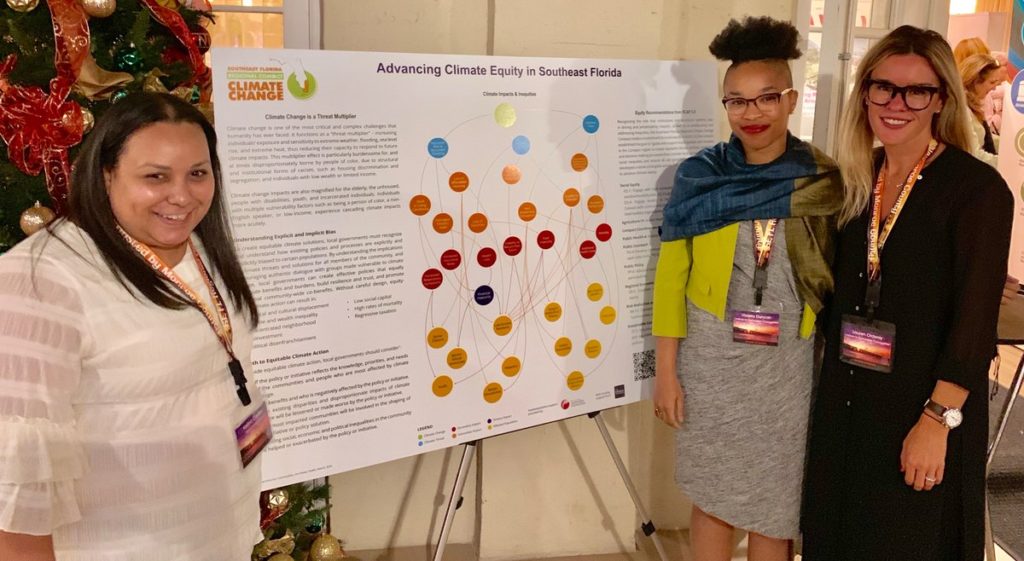So much of our work at ISC is about bridging gaps. Gaps between the myriad of uncoordinated departments, agencies, nonprofits, businesses, and individuals charged with keeping us healthy and safe; gaps between commitment to tackling climate and the ability to do so; and the chasm between recognizing the problem and implementing solutions.
So, I thought it was incredibly apropos that the theme of the 11th Southeast Florida Annual Climate Change Leadership on Dec. 3-5 was “Bridging the Gap.” The Summit was held this year in the Florida Keys, one hundred miles of islands connected by bridges. Our partner, the Southeast Florida Regional Climate Change Compact, represents the four counties that over six million Floridians call home, and has been a tremendous force in “minding the gaps” but there is still much to be done.
The Compact’s successes have inspired regional efforts in Tampa Bay, East Central Florida, and Northeast Florida to similarly fill the void left by state government. Florida now has four regional climate collaboratives and is second only to California in the number of these efforts. The geographies and politics across which these collaboratives operate reflects that for communities facing climate change impacts now, intractable partisanship is increasingly falling by the wayside in favor of the urgent imperative to respond.
This year’s Summit was imbued with a sense of possibility and new opportunity, as over the past year, we’ve begun to witness a paradigm shift from a “lost decade” of climate work within one of the most vulnerable states in the nation. For nearly 10 years, the Compact has quite literally bridged the gap while climate change was missing from the state government agenda. That “lost decade” seems to be ending as the state begins to respond to the threat.
So what gaps remain to be bridged? Well, even after a decade of work by the Compact, there are many.
Each year, UNEP releases its Global Emissions Gap Report prior to the annual Conference of Parties – the 2019 edition showed a significant gap between emission reductions needed to hit the 1.5C aspirational target articulated in the Paris Accord, and reality. Early this year, the Compact released an update to the regional GHG inventory to now cover 2005 – 2015. The results of the inventory indicate that emissions in transportation and stationary energy use decreased by approximately 10%. Additionally, Southeast Florida has decreased its carbon intensity (the amount of emissions resulting from each unit of economic output) by 28.3%.
This is good news and shows that we are beginning to decouple the regional economy from emissions, but cities across the country are struggling to meet ambitious emission goals, and we know that future regional efforts to reduce emissions will become increasingly more challenging as we continue to capitalize on opportunities. Decarbonization must happen at all levels of government and local efforts are critical. That said, to meet the challenge we face, they must be met with parallel effort at the state, federal, and global levels as well.

Karina Castillo, Miami-Dade Co.; Violeta Duncan, ISC; and Lauren Ordway, ISC (left to right) at the Summit
Finally, another gap remains to be bridged: issues of equity and justice. Over the past decade, as the Compact was formed and matured, so too has the practice of locally oriented climate adaptation and mitigation efforts throughout the country. In Southeast Florida and elsewhere around the country, many local governments responded to the climate challenge with urgency.
But with this sense of urgency, practitioners in Florida and around the country – myself included – failed to fully consider how climate policy or specific projects interacted with long-standing structural inequities in society. The connection is unquestionable. Within the past month, we have seen a peer-reviewed paper looking at adaptation on the North Carolina coast that demonstrates that the benefits of adaptation projects are accruing to more affluent communities.
The evidence is clear that well-intentioned climate policies and projects can harm, and have harmed, marginalized communities. We have to acknowledge that harm and we have to do better. We must bridge the equity gap by leveraging the response to climate change — a response that’ll reshape our communities, our commerce, and our lived experience — to address the structural issues that we’ve inherited and perpetuated to our detriment. Why wouldn’t we seize the opportunity to ensure that we all, as climate practitioners, do our part in advancing our national project of creating “a more perfect union?”
Over the past ten years, Southeast Florida has been a leader in inventing how we approach urban coastal resilience. In 1968, Garrett Hardin published the Tragedy of the Commons, which outlined how the pursuit of individual benefit from commonly-held resources results in undermining the good of the whole. Climate change is the ultimate expression of the tragedy of the global commons and the Compact demonstrated how collective action rather than going it alone creates conditions for a greater good.
Now, as the stakes (and seas) rise, the only way we stem the tide is through what the British call a “whole of government” response. In the U.S., that means cities, counties, states, and the federal government (but also the public and private sector) must work in concert – each covering the lanes that each can only do. The Compact has invented a critical piece of this whole of government approach, but the work is far from over – we all have many more gaps to bridge.
